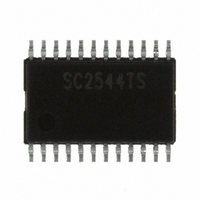SC2544TSTRT Semtech, SC2544TSTRT Datasheet - Page 8

SC2544TSTRT
Manufacturer Part Number
SC2544TSTRT
Description
IC CTRL/REG SYNC BUCK 24-TSSOP
Manufacturer
Semtech
Type
Step-Down (Buck)r
Datasheet
1.SC2544TSTRT.pdf
(24 pages)
Specifications of SC2544TSTRT
Internal Switch(s)
No
Synchronous Rectifier
No
Number Of Outputs
2
Voltage - Output
Adj to 0.75V
Frequency - Switching
100kHz ~ 300kHz
Voltage - Input
4.5 ~ 28 V
Operating Temperature
-40°C ~ 85°C
Mounting Type
Surface Mount
Package / Case
24-TSSOP
Lead Free Status / RoHS Status
Lead free / RoHS Compliant
Current - Output
-
Power - Output
-
Other names
SC2544TSTR
are simple passive component selection and ease of
feedback compensation. Before setting the operating
frequency, the following trade-offs should be considered.
For a given output power, the sizes of the passive
components are inversely proportional to the switching
frequency, whereas MOSFETs/Diodes switching losses
are proportional to the operating frequency. Other issues
such as heat dissipation, packaging and cost issues are
also to be considered. The frequency bands for signal
transmission should be avoided because of EM
interference.
Overview
Overview
The SC2544 is a constant frequency 2-phase voltage
mode step-down PWM switching controller driving all N-
channel MOSFETs. The two channels of the controller
operate at 180 degree out of phase from each other.
Since input currents are interleaved in a two-phase
converter, input ripple current is lower and smaller input
capacitance can be used for filtering. Also, with lower
inductor current and smaller inductor ripple current per
phase, overall I
The frequency of the SC2544 is user- programmable.
The oscillator of SC2544 can be programmed with an
external resistor from the Rosc pin to the ground. The
step-down controller is capable of operating up to
300KHz. The relationship between oscillation frequency
versus oscillation resistor is shown in Figure 1.
© 2005 Semtech Corp.
Overview
Overview
Overview
F F F F F req
POWER MANAGEMENT
Applications Information
The advantages of using constant frequency operation
req
req
req
requency Se
1) Passive component size
2) Circuitry efficiency
3) EMI condition
4) Minimum switch on time
5) Maximum duty ratio
uency Se
uency Se
uency Se
uency Setting
Figure 1. Switching frequency versus Rosc.
350
300
250
200
150
100
50
2
tting
tting
tting
tting
R losses are reduced.
Rosc(KOHM)
8
S t a r t - u p
S t a r t - u p
Shutdown
Shutdown
S t a r t - u p
S t a r t - u p
S t a r t - u p
During start-up, the reference voltage of the error
amplifier equals 30% of the voltage on Css (soft-start
capacitor) which is connected between the SS pin and
ground. When the controller is enabled (by pulling EN
pin high), one internal 84uA current source, I
start current) will charge the soft-start capacitor
gradually. The PWM output starts pulsing when the
soft start voltage reaches 1V.
This soft start scheme will ensure the duty cycle to
increase slowly, therefore limiting the charging current
into the output capacitor and also ensuring the
inductor does not saturate. The soft start capacitor
will eventually be charged up to 2.5V.
The soft-start sequence is initiated when EN pin is high
and Vcc >4.5V or during recovery from a fault condition
( OCP, OVP, or UVLO).
The period of start up can be programed by the soft
start capacitor:
By connecting different capacitors at SS1 and SS2
pins, VO1 and VO2 will start at different time, achieving
sequential start-up for the outputs. Connecting SS1
and SS2 together would make the 2 outputs start and
reach steady state values at the same time, achieving
ratiometric start-up.
Shutdown
Shutdown
Shutdown
When the EN pin is pulled low, an internal 15uA current
source discharges the soft-start capacitor and DRVH/
DRVL signals stop pulsing. The output voltage ramps
down at a rate determined by the load condition.
The SC2544 can also be shutdown by pulling down
directly on the SS pin. The designer needs to consider
the slope of the SS pin voltage and choose a suitable
pull down resistor to prevent the output from
undershooting.
Shutdown can also be triggered when an OCP condition
occurs. When an OCP condition is detected, DRVH and
DRVL will stop pulsing and enter a “tri-state shutdown”
with the output voltage ramping down at a rate deter-
mined by the load condition. The internal 15uA current
source will begin discharging the soft-start capacitor
and when the soft-start voltage reaches 0.65V, DRVL
will go high.
Tss
=
Css
84
×
μ
2
A
5 .
V
www.semtech.com
SC2544
SS,
(soft












